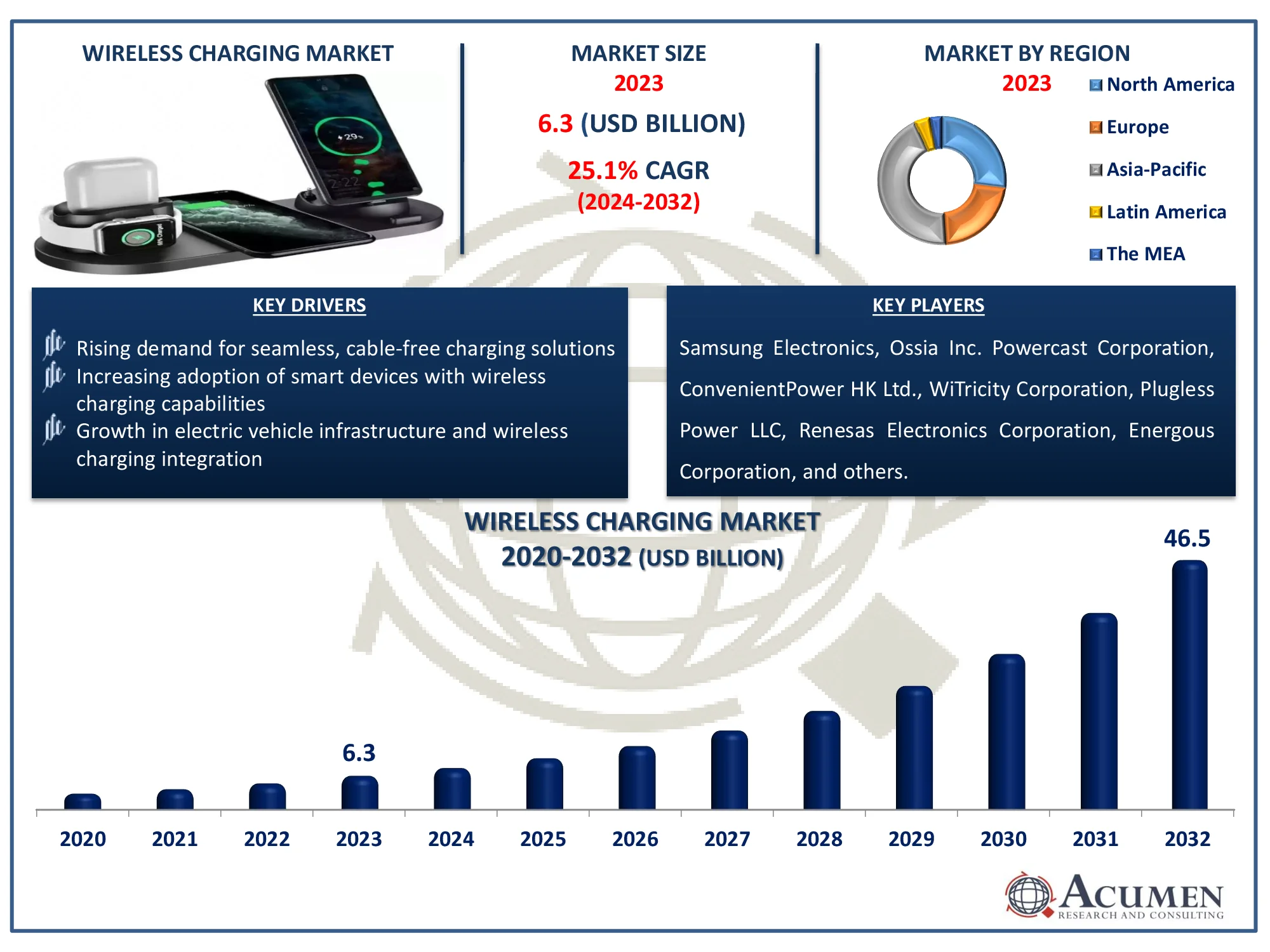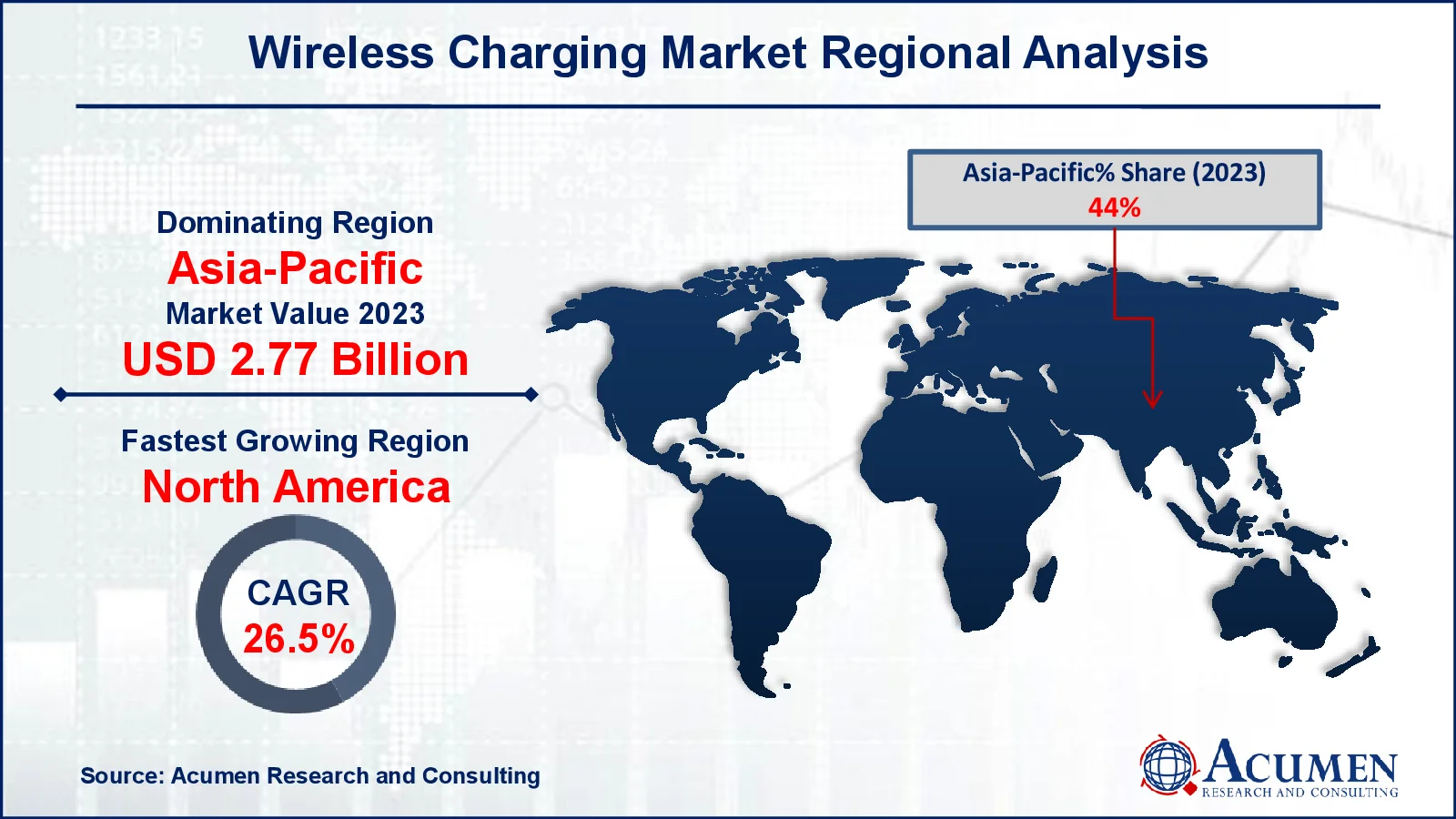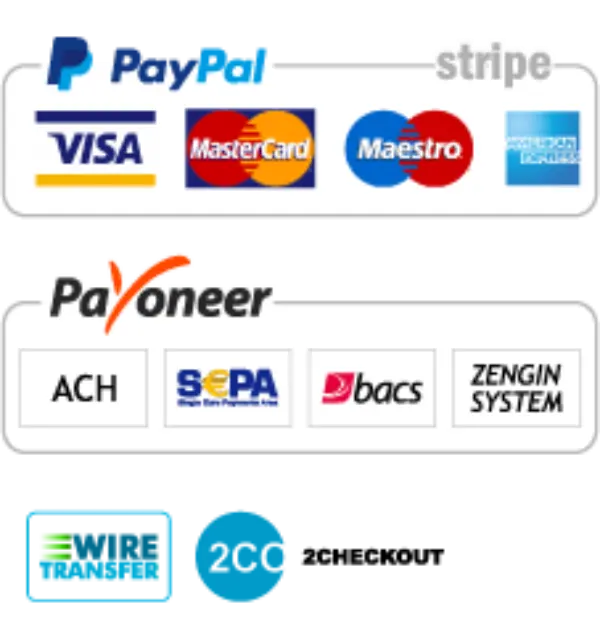Wireless Charging Market Size - Global Industry, Share, Analysis, Trends and Forecast 2024 - 2032
Published :
Report ID:
Pages :
Format :
Wireless Charging Market Size - Global Industry, Share, Analysis, Trends and Forecast 2024 - 2032
Report Coverage
- Industry Dynamics
- Market Size and Forecast Data
- Segment Analysis
- Competitive Landscape
- Regional Analysis with a Niche Focus on Country-Level Data
- High Level Analysis - Porter's, PESTEL, Value Chain, etc.
- Company Profiles of Key Players
- Option to Customize the Report As Per Your Specific Need
Request Sample Report
The Global Wireless Charging Market Size accounted for USD 6.3 Billion in 2023 and is estimated to achieve a market size of USD 46.5 Billion by 2032 growing at a CAGR of 25.1% from 2024 to 2032.
Wireless Charging Market Highlights
- The global wireless charging market is projected to reach USD 46.5 billion by 2032, with a CAGR of 25.1% from 2024 to 2032
- In 2023, the Asia-Pacific wireless charging market held a value of approximately USD 2.77 billion
- The North America region is expected to grow at a CAGR of over 26.5% from 2024 to 2032
- The inductive technology accounted for 38% of the market share in 2023
- The consumer electronics sub-segment captured 53% of the market share in 2023
- Development of universal standards to enhance device compatibility is the wireless charging market trend that fuels the industry demand

Wireless charging is a way of charging batteries with electrical equipment that are not physically connected by cables. Currently, charging smartphones is one of the most important aspects of any organization that uses power-intensive applications. The receiver and transmitter communicate using electromagnetic induction or microwaves. Wireless charging technology eliminates the need to carry several chargers for various gadgets. Wireless charging technology is altering the existing electronic device market, creating a requirement for new competent, standardized, safe, and portable power recharging options.
Global Wireless Charging Market Dynamics
Market Drivers
- Rising demand for seamless, cable-free charging solutions
- Increasing adoption of smart devices with wireless charging capabilities
- Growth in electric vehicle infrastructure and wireless charging integration
Market Restraints
- High cost of wireless charging devices and infrastructure
- Slower charging speeds compared to wired alternatives
- Lack of standardization across different wireless charging technologies
Market Opportunities
- Expansion of wireless charging in the automotive industry for electric vehicles
- Development of ultra-fast wireless charging technology
- Growth in industrial applications such as robotics and material handling
Wireless Charging Market Report Coverage
|
Market |
Wireless Charging Market |
|
Wireless Charging Market Size 2023 |
USD 6.3 Billion |
|
Wireless Charging Market Forecast 2032 |
USD 46.5 Billion |
|
Wireless Charging Market CAGR During 2024 - 2032 |
25.1% |
|
Wireless Charging Market Analysis Period |
2020 - 2032 |
|
Wireless Charging Market Base Year |
2023 |
|
Wireless Charging Market Forecast Data |
2024 - 2032 |
|
Segments Covered |
By Component, By Technology, By Application, and By Geography |
|
Regional Scope |
North America, Europe, Asia Pacific, Latin America, and Middle East & Africa |
|
Key Companies Profiled |
Samsung Electronics, Powercast Corporation, ConvenientPower HK Ltd., WiTricity Corporation, Plugless Power LLC, Renesas Electronics Corporation, Energous Corporation, Powermat Technologies, Texas Instruments, Inc., Ossia Inc., and Belkin International, Inc. |
|
Report Coverage |
Market Trends, Drivers, Restraints, Competitive Analysis, Player Profiling, Covid-19 Analysis, Regulation Analysis |
Wireless Charging Market Insights
The user-friendliness of wireless charging devices, combined with their capacity to charge numerous devices at once, is a fundamental driver of industry expansion. The global wireless charging market is primarily driven by increased smartphone usage with wireless charging capabilities, consumer demand for wireless communication, and device handling efficiency.
Furthermore, the increasing use of wireless charging technology in smartphones, tablets, and wearable gadgets like smartwatches, fitness bands, and other gear contributes to market growth. According to Darcy & Roy Press Organization, wireless charging is a cutting-edge technology with great promise. Its uses may go beyond mobile phones to encompass innovations such as continuous charging for laptops and wireless charging for electric vehicles, among others.
Wireless charging is particularly useful in hazardous industrial areas such as forestry, construction, mining machinery, and material handling applications. For example, the arXiv Organization defines IPT (Inductive Power Transfer) as a type of wireless charging that can transfer large amounts of power, frequently surpassing kilowatts, making it perfect for industrial automation. It is widely employed in applications such as robotic manipulation, automated underwater vehicles, induction generators, and induction motors. While the wireless charging business is likely to expand significantly in the next years, issues such as high costs, slower charging speeds, and lesser efficiency when compared to wire charging remain limits.
The increased adoption of smart gadgets, as well as continual advances in smartphone technology, are important drivers of the wireless charging market. The growing demand for sealed devices with extended battery life, coupled with the inconvenience of managing multiple chargers, is fueling the expansion of the wireless charging market. However, challenges such as the lack of standardization and the requirement for costly infrastructure to support technological advancements are hindering market growth.
 Wireless Charging Market Segmentation
Wireless Charging Market Segmentation
The worldwide market for wireless charging is split based on component, technology, application, and geography.
Wireless Charging Market By Component
- Transmitters
- Receivers
According to the wireless charging industry analysis, transmitters play a critical role since they generate the electromagnetic field required to transfer electricity wirelessly. These components are required to initiate the energy transfer process between the charging pad and the receiving device. The transmitter's efficiency and power output have a direct effect on charging performance and speed. As a result, developing high-performance transmitters is critical to increasing the overall effectiveness of wireless charging technology.
Wireless Charging Market By Technology
- Inductive
- Radio Frequency
- Resonant
- Others
Inductive technology dominates the wireless charging industry because to its dependability and broad use in a variety of applications, including smartphones and electric cars. This technique operates through electromagnetic induction, which transfers power between two coils i.e one in the transmitter and one in the receiver. Its effectiveness in charging over short distances makes it an excellent alternative for consumer gadgets and industrial applications. Inductive charging technology continues to dominate the industry due to its simplicity and efficacy.
Wireless Charging Market By Application
- Automotive
- Consumer Electronics
- Industrial
- Healthcare
- Defence
- Others
According to the wireless charging market forecast, consumer electronics dominate, owing to the growing demand for simple and efficient charging solutions in products such as smartphones, tablets, and wearables. As consumers seek more convenient charging options, wireless charging offers a more user-friendly alternative to traditional cable solutions. Wireless charging's rising usage in popular gadgets, driven by the need for faster and more efficient power transfer, reinforces its market domination. As technology advances, more consumer electronic devices will include wireless charging capabilities, further solidifying its position in the industry.
Wireless Charging Market Regional Outlook
North America
- U.S.
- Canada
Europe
- U.K.
- Germany
- France
- Spain
- Rest of Europe
Asia-Pacific
- India
- Japan
- China
- Australia
- South Korea
- Rest of Asia-Pacific
Latin America
- Brazil
- Mexico
- Rest of LATAM
The Middle East & Africa
- South Africa
- GCC Countries
- Rest of the Middle East & Africa (ME&A)
 Wireless Charging Market Regional Analysis
Wireless Charging Market Regional Analysis
For several reasons, North America is the major market for wireless chargers due to its more developed infrastructure than other regions. In 2023, the Wireless Power Consortium, Inc. (WPC) is expected to release a new wireless charging standard with the purpose of unifying the industry under a single global standard. As a result of this advancement, North America's wireless charging market is expected to grow dramatically as businesses and consumers adopt the new standard for greater compatibility and efficiency.
Asia-Pacific is expected to dominate the market in the next years, outpacing all other regions. This is due to the rising growth of consumer electronics in the Asia-Pacific region. According to the India Brand Equity Foundation, the Ministry of Electronics and IT's 'A call to action for widening and deepening electronics manufacturing' study states that India aspires to achieve $300 billion in electronics manufacturing by 2026. Furthermore, the widespread adoption of this technology for wireless charging has enabled market players to broaden their product offers.
Wireless Charging Market Players
Some of the top wireless charging companies offered in our report include Samsung Electronics, Powercast Corporation, ConvenientPower HK Ltd., WiTricity Corporation, Plugless Power LLC, Renesas Electronics Corporation, Energous Corporation, Powermat Technologies, Texas Instruments, Inc., Ossia Inc., and Belkin International, Inc.
Frequently Asked Questions
How big is the wireless charging market?
The wireless charging market size was valued at USD 6.3 billion in 2023.
What is the CAGR of the global wireless charging market from 2024 to 2032?
The CAGR of wireless charging is 25.1% during the analysis period of 2024 to 2032.
Which are the key players in the wireless charging market?
The key players operating in the global market are including Samsung Electronics, Powercast Corporation, ConvenientPower HK Ltd., WiTricity Corporation, Plugless Power LLC, Renesas Electronics Corporation, Energous Corporation, Powermat Technologies, Texas Instruments, Inc., Ossia Inc., and Belkin International, Inc.
Which region dominated the global wireless charging market share?
Asia-Pacific held the dominating position in wireless charging industry during the analysis period of 2024 to 2032.
Which region registered fastest CAGR from 2024 to 2032?
North America region exhibited fastest growing CAGR for market of wireless charging during the analysis period of 2024 to 2032.
What are the current trends and dynamics in the global wireless charging industry?
The current trends and dynamics in the wireless charging industry include rising demand for seamless, cable-free charging solutions, increasing adoption of smart devices with wireless charging capabilities, and growth in electric vehicle infrastructure and wireless charging integration.
Which technology held the maximum share in 2023?
The inductive technology held the maximum share of the wireless charging industry.


